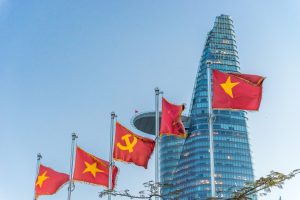Vietnam has just concluded a long traditional Lunar New Year holiday to embark on a “revolution” of institutional reforms designed to streamline the party-state apparatus. Right before the holiday, the Central Committee of the Communist Party of Vietnam (CPV) approved the streamlining plan submitted by the government. The next and final step of this revolution is that the Party-controlled National Assembly will organize an extraordinary session, expected on February 12-17, to nominally effectuate the plan.
According to the approved proposal, the government will winnow its institutional framework down to 14 ministries and three agencies; at the same time, 13 general departments, 738 departments and bureaus, and 3,303 sub-departments will be eliminated, and 201 public service units will be dissolved. Over 100,000 state civil servants will, in principle, be laid off and removed from state agencies. In the face of concerns in society and particularly the frustration of employees likely to be affected by the streamlining program, top Party and government leaders have called for sacrifices from cadres and Party members, and claim that this revolution has achieved unity and very high consensus in the Party and society, although they haven’t provided convincing evidence.
However, while the CPV Politburo and Central Committee are focused on revolutionizing the operational apparatus, meaning the micro- or middle-level, they seem to have forgotten or overlooked the supreme decision-making apparatus, or the CPV’s macro-level power structure. This is an extremely sensitive and challenging issue because it involves the concentration and control of power, and particularly the striking of power balance between factions. Balancing power represents the “CPV way” of ensuring unity and cohesion within the Party; it has even arguably been key to the CPV’s survival.
The macro-level power structure here refers to the four highest positions of the party-state, colloquially known as the “four pillars”: the position of Party chairman (during Ho Chi Minh’s time) or general secretary (after Ho’s death), and the posts of president, prime minister, and National Assembly chairman. While the authorities of the third and fourth positions are easily distinguished, the boundaries between the first and second positions are sometimes blurred, especially so in recent terms.
The CPV Statutes prescribe that the general secretary is the chief of the Party and chairperson of the Central Military Commission that controls the military. Meanwhile, the Constitution, most recently amended in 2013, stipulates that the president is the head of state and commander-in-chief of the armed forces, but is placed under the Party’s leadership. In practice, the general secretary is the person with the highest national authority. This leads to the perception that the position of president is merely ceremonial and lacks real power.
This perception seems to have been further reinforced in the CPV’s 12th tenure (2016-2021) and the current 13th tenure, where in many cases the general secretary has also simultaneously acted as the de facto head of state. For example, General Secretary To Lam has directly held telephone talks with several heads of state, including U.S. President Donald Trump, and Chinese leader Xi Jinping. In December, he also made a state visit to Malaysia and, together with the host prime minister, upgraded bilateral relations to a comprehensive strategic partnership. These are all state-level diplomatic activities, a function that the president is constitutionally mandated to perform.
The CPV previously had a political project to renovate the Vietnamese political system during the 2001-2010 period, which included a proposal for the general secretary to serve concurrently as president. However, the project was not executed because it was “not the right time yet.” One of the questions raised at the time was, who would have sufficient prestige and qualities to simultaneously hold both positions?
In October 2018, following the sudden death of President Tran Dai Quang, General Secretary Nguyen Phu Trong simultaneously took on the role of president until April 2021. Although Trong branded this a “situational” decision and simultaneously issued a warning about the concentration of too much power in any individual, the CPV Central Committee and the National Assembly unanimously backed this decision, viewing it as consistent with global political practices.
Last year, Lam was in the same situation as Trong in 2018. In August, he was elected general secretary after Trong’s sudden death in July. Three months earlier, Lam had been elected president. And so for about three months, Lam led a series of bilateral and multilateral diplomatic activities in the capacity as both president and CPV general secretary. This is something that no previous CPV leader had done since Vietnam initiated the Doi Moi reforms in 1986.
The current “revolution” of the Vietnamese political system is an auspicious moment for the CPV to move towards a parallel revolution in the macro-level power structure of the Party. Could the dissolution and transfer to the Ministry of Foreign Affairs of most functions of the Central Commission for External Relations, an agency originally responsible for the diplomatic activities of the general secretary and Politburo members, be a step towards realizing the protracted political project in which the general secretary will simultaneously serve as head of state?
The challenge is not about an individual being empowered, but about how the power is controlled and how the officeholder can be held accountable. If it was “not the right time yet” in the early 2000s, then when will the right time be? The more delayed the execution of this project, the more the dilemma the CPV faces in domestic politics and international relations. The CPV now has a choice to undertake the project, either now or after the 14th congress in 2026. Naturally, both the Constitution and the CPV Statutes need to be amended before this can happen. Until then, Vietnam’s institutional and political reforms will be incomplete and the central government will not be able to set an example for the rice-roots to follow.

































